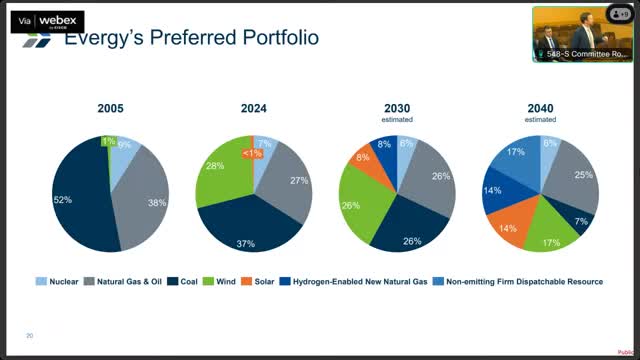Energy Security at Stake as Solar Projects Face Backlash
October 09, 2024 | Joint Committee on Kansas Security, Joint, Committees, Legislative, Kansas
This article was created by AI summarizing key points discussed. AI makes mistakes, so for full details and context, please refer to the video of the full meeting. Please report any errors so we can fix them. Report an error »

In a recent government meeting, discussions centered on the evolving landscape of energy production, particularly the integration of solar and wind power into the energy portfolio. Representatives expressed concerns about the substantial land requirements for solar energy projects, with estimates suggesting that commercial solar facilities could require between 8,000 to 13,000 acres. This has raised alarm among local residents and officials, who likened the impact to deforestation and questioned the feasibility of such large-scale projects.
Representative Smith highlighted the need for reliable energy storage solutions to complement solar energy, especially given the variability of weather conditions. He emphasized the importance of addressing community concerns regarding the footprint of solar installations and the potential security implications for law enforcement agencies tasked with protecting these facilities.
In response, Evergy representatives acknowledged the trade-offs associated with solar energy, noting that each megawatt of utility-scale solar requires approximately 5 to 6 acres of land. They emphasized that while solar is a cost-effective option for meeting peak energy demands, it cannot be the sole solution for future energy needs. The company plans to adopt a diversified approach, incorporating various energy sources, including wind and natural gas, to meet carbon reduction targets mandated by new greenhouse gas regulations.
The conversation also touched on the role of federal incentives in making solar and wind energy economically viable. Evergy officials indicated that while subsidies significantly enhance the cost-effectiveness of these technologies, the long-term strategy will need to balance economic considerations with regulatory requirements for carbon emissions.
As the energy landscape continues to shift, stakeholders are urged to consider both the environmental impact and the community's readiness to embrace large-scale renewable energy projects. The meeting underscored the importance of ongoing dialogue between energy providers, government officials, and local communities to navigate the complexities of transitioning to a more sustainable energy future.
Representative Smith highlighted the need for reliable energy storage solutions to complement solar energy, especially given the variability of weather conditions. He emphasized the importance of addressing community concerns regarding the footprint of solar installations and the potential security implications for law enforcement agencies tasked with protecting these facilities.
In response, Evergy representatives acknowledged the trade-offs associated with solar energy, noting that each megawatt of utility-scale solar requires approximately 5 to 6 acres of land. They emphasized that while solar is a cost-effective option for meeting peak energy demands, it cannot be the sole solution for future energy needs. The company plans to adopt a diversified approach, incorporating various energy sources, including wind and natural gas, to meet carbon reduction targets mandated by new greenhouse gas regulations.
The conversation also touched on the role of federal incentives in making solar and wind energy economically viable. Evergy officials indicated that while subsidies significantly enhance the cost-effectiveness of these technologies, the long-term strategy will need to balance economic considerations with regulatory requirements for carbon emissions.
As the energy landscape continues to shift, stakeholders are urged to consider both the environmental impact and the community's readiness to embrace large-scale renewable energy projects. The meeting underscored the importance of ongoing dialogue between energy providers, government officials, and local communities to navigate the complexities of transitioning to a more sustainable energy future.
View full meeting
This article is based on a recent meeting—watch the full video and explore the complete transcript for deeper insights into the discussion.
View full meeting
